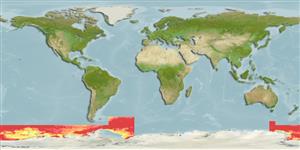Classification / Names
Common names from other countries
Main reference
Size / Weight / Age
Max length : 35.0 cm TL male/unsexed; (Ref. 1371); common length : 27.0 cm TL male/unsexed; (Ref. 1371)
Length at first maturity
Lm ?, range 23 - 32 cm
Environment
Marine; pelagic-oceanic; depth range 10 - 1600 m
Climate / Range
Polar, preferred -2°C (Ref. 107945); 50°S - 78°S, 143°E - 19°W (Ref. 1371)
Distribution
Southern Ocean: coasts of Antarctic Peninsula, Scotia Sea (South Georgia, South Sandwich, South Orkney and South Shetland islands), Victoria Land and Ross Sea.
Countries | FAO areas | Ecosystems | Occurrences | Introductions
Short description
Dorsal
spines
(total): 0;
Dorsal
soft rays
(total): 135;
Anal
spines: 0;
Anal
soft rays: 106;
Vertebrae: 69. Dorsal filament variable in length, but never longer than twice the eye diameter. Outer rays of the pelvic fins filamentous, of unequal lengths. Lateral line arched above the pectoral fin, extending to slightly beyond the pectoral fin tips. Color is uniform gray-brown, with iridescent hues.
IUCN Red List Status (Ref. 115185)
Threat to humans
Harmless
Human uses
Fisheries: minor commercial
More information
Age/SizeGrowthLength-weightLength-lengthLength-frequenciesMorphometricsMorphologyLarvaeLarval dynamicsRecruitmentAbundance
ReferencesAquacultureAquaculture profileStrainsGeneticsAllele frequenciesHeritabilityDiseasesProcessingMass conversion
Tools
Special reports
Download XML
Internet sources
Estimates of some properties based on models
Phylogenetic diversity index
PD50 = 0.5059 many relatives (e.g. carps) 0.5 - 2.0 few relatives (e.g. lungfishes)
Trophic Level
3.4 ±0.4 se; Based on diet studies.
Resilience
Medium, minimum population doubling time 1.4 - 4.4 years (tm=4; Fec = 85,810)
Vulnerability
Moderate to high vulnerability (47 of 100)
Price category
